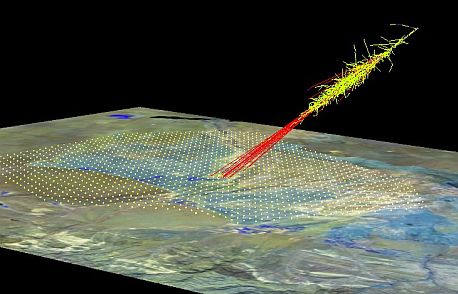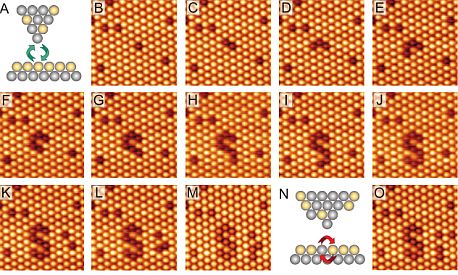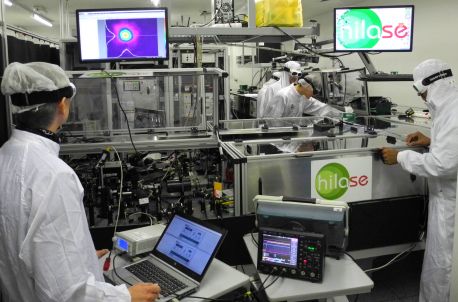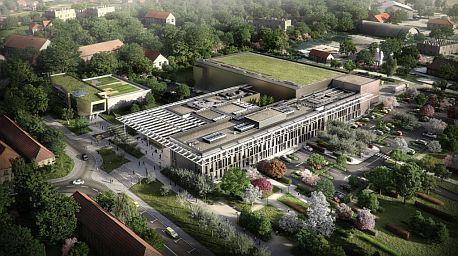The present research programme of the Institute encompasses physics of elementary particles, condensed systems, solid state, plasma physics, and classical and quantum optics.
The research in elementary particle physics is carried out mostly within broad international collaborations. We participate in experiments at the large accelerators at CERN near Geneva in Switzerland and at Fermilab in the USA, where the deepest structure of matter and forces governing the microcosm are studied. Closely connected are our activities in the development of particle detectors.
 View inside the ATLAS detector
in the underground experimental hall of the LHC at CERN.
View inside the ATLAS detector
in the underground experimental hall of the LHC at CERN.
The particle physics research involves also astroparticle physics – the field in between particle physics and astrophysics. Cosmic rays of the highest energies are studied within an international collaboration at the Pierre Auger Observatory in Argentina, the world’s largest experimental facility of its kind. Besides, there is engagement in theoretical and mathematical physics and application of particle beams in medicine.

Simulation of a cosmic ray shower induced by a high-energy proton and hitting the detector array of the Pierre Auger Observatory (created by the Cosmus group of the University of Chicago).
The physics of condensed systems is focused on dynamical and cooperative phenomena in disordered and inhomogeneous materials, and in systems with reduced spatial dimensions. The main objects of interest are condensed materials exhibiting prominent physical properties, or subject to extreme conditions. We deal with preparation and research of functional materials, such as composites, superconductors, liquid crystals, and shape memory alloys, in the form of single crystals, polycrystals, nanostructured materials, thin films and coatings, combining theoretical, experimental and novel technological approaches.
 The texture in
a liquid crystal (TGBA phase)
The texture in
a liquid crystal (TGBA phase)
The research in the domain of solid state physics is oriented towards new forms of solids, new physical phenomena and principles of microelectronic components. The properties of new materials are determined by their surface, defects, nanometric, layered or aperiodic structure. Characteristic is the interconnection of advanced technologies of preparation, unique methods of their characterisation in a broad range of external conditions, down to nanometric and atomic level, as well as processing of results with the aid of microphysical and ab-initio theoretical calculations. Great attention is paid to magnetic and optically active materials, nanocrystalline forms of silicon, III-V semiconductors, diamond and graphite, as well as to nanostructures for applications in medicine and microelectronics.

The process of formation of a predefined pattern using atomic force microscopy (AFM): in this case the letter S is composed of single silicon atoms (dark circles) on the surface of tin crystal (light circles).
The preparation of new optical materials for optoelectronics is based on use of new plasma and hybrid techniques. The research in the field of quantum optics is focused on development of various types of sources of quantum-correlated photon pairs and on devices for transmission of underlying information.

In the field of High Power Photonics, we study lasers and laser produced plasmas. The HiLASE laser centre (www.hilase.cz) is the spin-off of the terawatt iodine laser system PALS. HiLASE project focuses on the research and experimental development of novel high energy, pulsed diode-pumped solid state laser systems with high repetition rates and average output power on kW level. Our laser systems will be significantly more powerful, compact, efficient and will offer an easier maintenance. Therefore they have a great potential not only in basic science but also in applied research and high-tech industry.

ELI Beamlines, one of the most advanced research laser centres in the world, will be available from 2018. It should be a truly multi-functional centre where not only physicists, but also chemists, biologists and others, including industrial companies can carry out the necessary experiments. The combination of ELI laser technology should be truly unique.
The largest currently built infrastructure of the Institute of Physics of the AS CR belongs to the field of laser physics and it is called the Extreme Light Infrastructure (ELI). This project is part of a European plan to build a new generation of large research facilities selected by the European Strategy Forum for Research Infrastructures (ESFRI). The main goal of ELI is to create one of the latest laser equipment in the world. There will be accomplished and implemented research projects covering the interaction of light with matter at intensity being many times higher than currently achievable values. ELI will provide ultra-short laser pulses of a few femtoseconds (10-15 fs) duration and give performance up to 10 PW. ELI will bring new techniques for medical image-display and diagnostics, radiotherapy, tools for new materials developing and testing, latest in X-ray optics, etc. ELI will also be an attractive platform for educating a new generation of scientists. More information about the ELI Beamlines project is available at www.eli-beams.eu
Copyright © 2008-2010, Fyzikální ústav AV ČR, v. v. i.